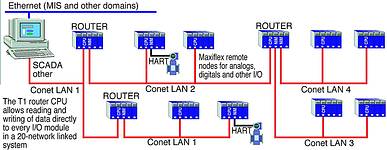
The 'TI' CPU is designed specifically for remote I/O, offering four major new features in a combination of technologies that enhance functionality, user-friendliness and value to the user. Omniflex ensured that by retaining all of the previous generation CPU functionality, the TI is 100% backwards compatible for the older Maxiflex systems.

Enhanced data access through the virtual DIT
The Data Interchange Table (DIT), which is used to store parameters and I/O variables, has been increased from 4000 to 64 000 registers, with each I/O slot in a Maxiflex node now allocated 4000 registers. Thus the network can read and write all I/O and configuration parameters directly without the need for any user programming. The major benefit is that all of the data within a Maxiflex rack is totally available to the network, right down to I/O level, with no programming effort.
Internetworking routing
Secondly, following the ISO OSI 7-layer network model, new developments in the network layer have resulted in a powerful facility for reaching right down to the factory floor in very large, geographically spread-out Conet networked installations. While much debate prevails over the choice of fieldbus to use, Omniflex has quietly taken Conet internetworking to a new level of user friendliness and functionality and the TI CPU, together with network interface modules (NIMs) provide a zero programming combination.
The internetworking feature very simply means that the TI CPU has a built-in router that enables the user to link many dissimilar networks into a single seamless intranet. The routing is easily configured using the ConetRouterWizard spreadsheet that is downloadable from the Omniflex website at www.omniflexdirect.com. This spreadsheet saves days and possibly weeks of configuration on internetworked Conet installations. The NIMs enable Conet networks to be extended indefinitely (so that distance is no longer an issue), at the same time facilitating star configurations with a central hub or multiple hubs.
Plug and talk
The TI CPU also automatically monitors the presence of any I/O module in the system and, without the need for a programmer to write a single line of code, scans these and writes the I/O values into corresponding DIT registers for quick and easy network access. The CPU keeps a copy of the module configuration parameters in nonvolatile memory so if any I/O module requires replacement, it is instantly reconfigured and updated as it is plugged in - without user intervention.
Any Maxiflex I/O module can be plugged into any slot in the base and it is instantly recognised and included in the scan tasks without any user intervention, thus taking data acquisition and control to a new level of user friendliness.
Built-in I/O scanner
In order to speed up the access of data from the network, an efficient I/O scanner reads inputs and writes outputs to the dynamic data (I/O) registers every 10 ms. It also makes a live copy in the CPU's own DIT, thus making it much easier and more efficient for scada and other host systems. It also groups all digital data together into a live map in the CPU, so that a single block read form another device will collect the entire node's status at once. Likewise all analog data is grouped together, resulting in significant response time improvements for data acquisition.
Future expansion
The TI CPU has also been designed for future expansion and integration with MIS systems on networks such as Ethernet, where factory floor data can be instantly and easily accessed by any application on the corporate LAN/WAN. The implications for managers who wish to snap view into a particular process or portion of the plant (eg production counts, downtime hours, stoppage reasons etc) are substantial, as the system allows for simple access and data transfers.
A special network interface module (NIM) in design will interface to any HART protocol field device so that remote data can be collected and transported across any Conet LAN or intranet.
According to David Celine, Managing Director of Omniflex: "We have been designing and building quality industrial instrumentation products for over three decades, for all types of industries, on all continents. With years of PLC, networking, I/O, scada and other experience we realised that something different had to be done. This new TI CPU on the reliable Maxiflex platform may not be the ultimate system, but in our opinion, it certainly beats anything else we know of in the marketplace.
"Our beta testing has come up trumps and we believe that our existing clients will leverage what the TI offers in expanding and developing systems that may be nearly 20 years old in some cases. This is a classic case of true backwards compatibility engineering.
"While our traditional strengths and influence have been in brownfield projects, the TI offers unrivalled functionality and we are expecting the product and associated system to be specified in many upcoming greenfield projects. Our maxim here is 'Good technology should be transparent to the user'."
Omniflex
(031) 207 7466

© Technews Publishing (Pty) Ltd | All Rights Reserved